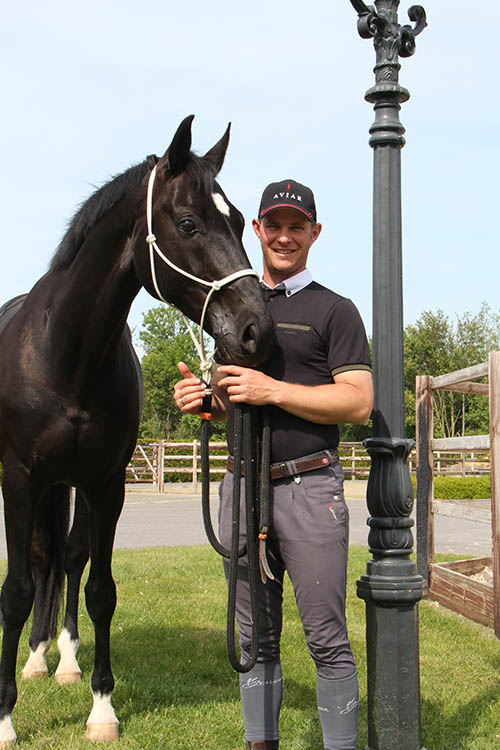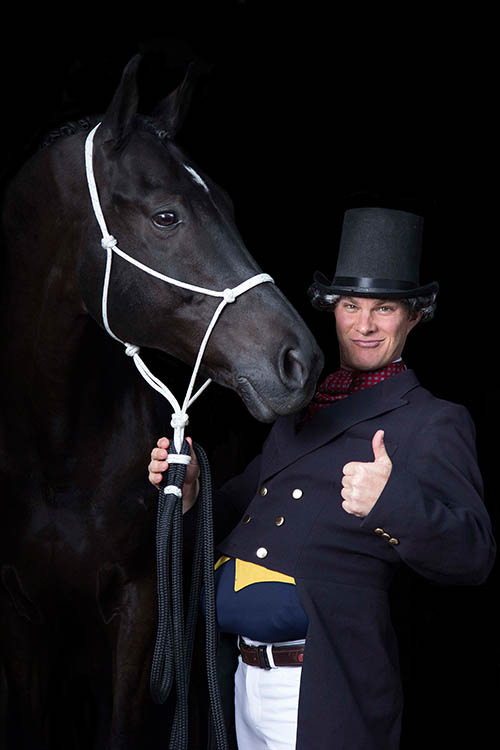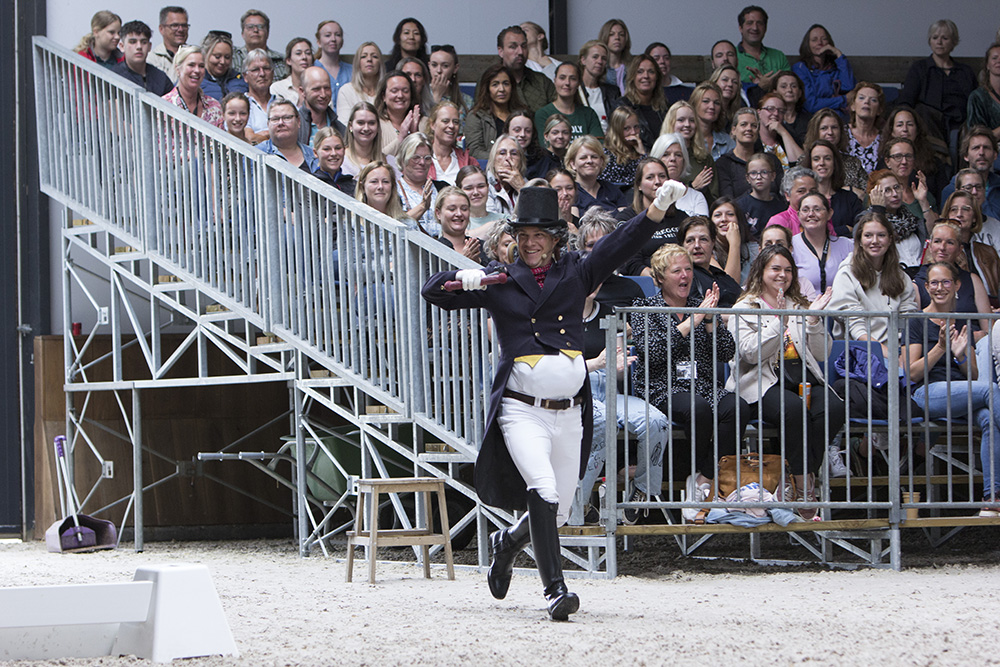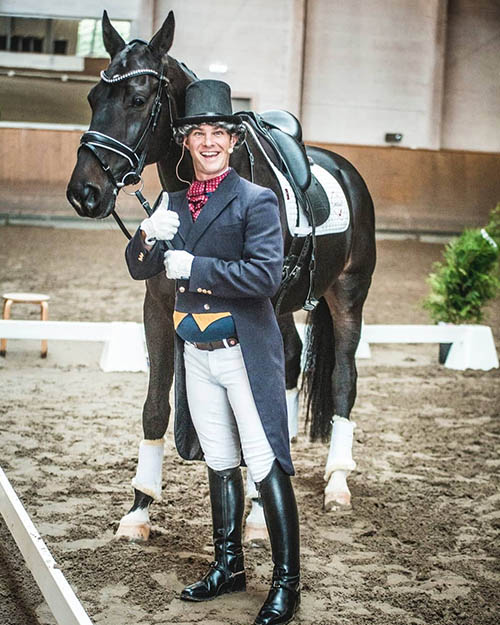Tristan Tucker is well known on the global equestrian stage as an educator, entertainer, Grand Prix dressage rider and, above all, a brilliant horseman. We catch up with the Netherlands-based Aussie to learn more about how he’s helping horses and their owners through his growing TRT Method program – including how to handle the common issue of paddock anxiety.

“It has become something that
we didn’t really realise in the beginning.”
When Equestrian Life last spoke to Tristan Tucker two years ago, his online training program, TRT Method, had 14,000 members across 60 countries. Driven by demand through the Covid period – and buoyed by a never-ending quest to improve and evolve – TRT Method recently ticked over to a staggering 40,000 members in 69 countries. Many online horsemanship training programs exist, however, very few have achieved meteoric growth or created a truly engaged family of students to the degree that the TRT Method has.
“We have a very large community now. Covid was actually a very good thing for us… we’d already been going for six years when the pandemic hit,” explains Tristan. “During that time, where all the spaces and places that we normally connect and be with our horses were restricted, this for us meant that people could come and still feel that they were following their horse journey. We have a great community with a lot of members supporting each other. It’s a space where everybody’s there for the same reason, and so people feel a lot of support and gain a lot of feedback from other members.
“Now hitting 40,000 members, it has become something that we didn’t really realise in the beginning. At the start, we were filming myself working a few horses and I would do my thing, thinking, ‘Oh, this might help Wendy down the road who’s having trouble getting on her horse’. But you don’t realise that when you create a group of people of the size we have, how that connects people with a common passion around the world. It’s a really healthy environment and people are really for each other and encouraging each other; they’re sharing stories, emotions, their true feelings about what they’re doing.
“Some of the stories that come out of what the members are going through and have been through, and what the online training has given them – not only skills to work their horse, but true belief in themselves, lasting change, being able to overcome things that they thought they never would be able to – that is inspirational and empowering. Some of the stories also made me realise that we just didn’t create an online program for helping people with their horses, but a place where people were having real personal growth and they were creating life stories that were incredibly inspirational for me and my team. It’s as much rewarding for us as it is for the members.”
Tristan explains that now with so many members, he and his team are equipped with a lot more information about what people really need. “In the beginning of the program, we were putting together my step-by-step of how I do things – but now we can see which parts are missing and what people really need. This means we’re able to now design the courses to really fit the people. We have a lot of contact with our students; we are doing Q&A’s twice a month, we get to see videos of how people are doing, we have a challenge every month with the opportunity to enter a competition. This all gives me an idea of what things people are really good at and what they need more help with… you really get to know the horse community.”

PADDOCK ANXIETY
One such common problem that Tristan discovered is paddock anxiety. We’ve all seen it: horses that, when turned out for some paddock time, find it hard to settle and potentially risk injury through their panicked behaviour. Like most problems faced by horse owners, Tristan has some words of wisdom to help with the turn-out terrors.
EQ LIFE: Why is paddock time so important for our horses?
TRISTAN: For me – apart from the obvious things like being able to go out and have fresh air and see a different environment than the inside of the stable – to be within the environment, to hear the birds, to feel the wind, to be able to move in a different way than they’re able to do in the box. Aside from these obvious things, for me it’s really important to get the social interaction.
We’re often putting horses in pairs or together in a group. For me, the interaction with the other horses is a different conversation; a social connection with horses often brings a different level of energy. This is like the time out, the recharge. I find a lot of my horses, if they’re out playing, jumping and cantering around a little bit, playing with their friends, when they come in or the following day, they have a different sense of energy; they have had the recharge. They’ve been able to let their brain switch on to something else.
Quite often if the horses are in training and I want them to think about something afterwards, I’ll put them back in the stable and let them be quiet and have the rest. And so that break of then going outside and being social, having that connection and contact with another horse – allowing them to scratch each other’s neck, allowing them to explore and have these conversations with their four-legged friends – is important.

“The anxiety is something real
and it can be highly stressful for horses.”
EQ LIFE: What are the main things that lead to a horse developing paddock anxiety?
TRISTAN: This comes from a general insecurity in the horse. When a horse is not good at managing himself or letting himself feel comfortable in a lot of the different situations, then of course he’s instead seeking the approval and comfort of others. Often our environment, schedule and plans, and the systems that we run in the stable, can cause this.
Young horses… they go from the mother, they get put into a group, they create bonds and connections with the other horses, and then when they’re old enough and are to be ridden, they’re taken from that group and they’re put in a stable. This is often by themselves and they’re not yet given skills of how to be independent and what it is to feel comfortable in their own skin in order to feel that they’re going to be successful in the questions that are going to be asked in a human environment. They’re brought into a stable with the skills that only Mother Nature gave them, which they further developed by being in a group with other young horses. Even though that is healthy, it’s important that they have the skills of the real environment they’re born into, our human environment, to be able to be well equipped to feel confident in all situations they find themselves in.
So these young horses, they go through the process of coming into a stable environment, and then often our plan is to put them out in a paddock on their own… and they can maybe see another horse in the distance, or they’re taken away from the mates that they’ve now been able to talk to in the stables, and so we’re emphasising this insecurity of needing the other horses, and they become anxious.
The worst possible thing that cements this pattern of behaviour and anxiety is that when they are getting a little bit anxious and running around and calling out, the human often takes the horse back in to its place of comfort, because we’re afraid of the horse getting injured and don’t want to see them distressed. That then emphasises a sense of security that, ‘Oh, I was screaming out for the others and now I’m with my friend… I’m glad I did that because if I didn’t use what Mother Nature told me, then maybe I would have been alone forever.’ The anxiety is something real and it can be highly stressful for horses.
Of course, on the other hand, you don’t want to leave them and let them run themselves back to tiredness or another place we don’t want them to be – but if you do the training in the beginning, then you are able to intervene.

“It’s about being the mentor
and explaining what’s going on.”
EQ LIFE: How do you go about addressing the problem?
TRISTAN: The important thing is in your general training to give your horse the knowledge and the security of what he has to do with himself in any given situation. This is about him being comfortable within his physiology and having a good awareness where the tension patterns are in his body.
We know ourselves if we get into a situation where we’re about to face something – we’re about to get up and speak, or we’re going to an important interview, or we have to go and meet our in-laws or something that creates a bit of expectation – sometimes our physiology goes into a state of protection because we’re unsure. We start to get tense and tired in our bodies, sometimes unconsciously. Our physiology starts to change; ultimately, we may get worried to a point where our physiology starts to let us feel mentally that we’re in a panic state. It’s often felt and proven both in humans and horses that when we get into a state of being anxious that we have a disconnection from our mental state and our physical state; we no longer feel what our body is doing. We’re getting into the flight, fight, or freeze mode, the latter being a complete shutdown where there’s no connection to your physical state anymore. This is the same for the horse.
It’s important that we are giving them the understanding of how to keep a relaxed physiology with the ability to reduce tension if they feel it. So firstly, the awareness: ‘do I have tension coming into my body?’ And then, ‘how do I get rid of that tension, so I don’t start to worry about the situation… what physical action can the horse take to make himself feel better?’
We’re able to do this through basic ground patterns. We’re giving the horse a feeling of connection, a good order of movement. Developing that in your horses is, in the beginning, a very good starting place, to develop confidence and the belief that he can manage himself.
Horses that are becoming insecure out in the field, I go to them and go through these patterns that we’ve already practised. When they are calling out for other horses, you can be the one that helps them to manage themselves; you become the mentor. It’s not about going in and saying, ‘Good boy, good boy, be calm’. It’s about being the mentor and explaining what’s going on in their physiology and what they can do and change in the way they move and connect with themselves to get their shit together again!
It is the same if the horse is anxious in the stable, such as when a horse leaves, and your horse gets in a panic. I go into the stable or I take the horse to our working place, and I go through these patterns where I have a space to allow the horse to get to a relaxed state.
We don’t want to be letting the horse go through these motions, and then at some stage feeling the release of the other horse coming back and him thinking, ‘Oh, thank God. I screamed and panicked and jumped up against the bars and paced up and down because I thought he was never coming back. And now I have the feeling that he comes back after that action’. So in this case, taking the horse out or being in with the horse until it gets to a relaxed state is important. In this stable scenario, sometimes I do take the horse away, then I bring the other horses back first – and when the panicked horse reaches a relaxed state, he returns. This is breaking the pattern; you don’t want to build a pattern of anxiety that grows every time the horse is separated from another.
It’s also then about the basic interactions with other horses, not keeping them isolated… I do this in the beginning with the young horses in the arena, working them together, working them free together so that they learn the social behaviours and the interactions and that they don’t have to cling to another horse to feel that security.
Developing these skills allows your horse to be very comfortable within his own skin, and then he’s not in an insecure state where he has to look for a source of security outside of himself. This is the self-management skill, which we give constantly through our TRT program.

EQ LIFE: What are some of the common misconceptions you see when dealing with horses that have this sort of anxiety?
TRISTAN: The biggest misconception is that you should not put them out! When anxious horses come in for training, I ask the routine, and a lot of the time it’s, ‘Oh no, he can’t go out. He’s never been out. He doesn’t go out. In between him being in the stable, we only walk him in hand a couple of times.’
There are a lot of techniques that people try that lead them in the wrong direction, such as always putting another horse in to keep the anxious horse company. This is not giving him skills, it’s giving him a false sense of security.
For me, this is just a lack of knowledge in the human that we can have the ability to give the horse the skills to teach him to be relaxed when he is out in the paddock. And of course, it’s our doing in the first place. Horses are not born with separation anxiety; this is developed through the patterns and through the systems that we build and the environment they’re put into.



THE YEAR AHEAD
Tristan explains that the beginning of 2022, he closed his training stable so that he had more time to focus on developing his own horses and of course also the TRT Method – and as 2023 begins, these two things remain his focus.
Tristan and his wife, Katja Gevers – who is also a Grand Prix dressage rider – have 13 horses in work, and that’s more than enough to keep them busy! “I have a handful of Grand Prix horses. We have two young daughters, so my wife is now getting back into riding and competing – she also has a handful of Grand Prix horses. This year, we’ll starting to show a little bit more. My wife’s parents are also breeding our own horses, so we have two foals a year and we are riding and training the horses that we breed ourselves.
“We also have Brett Kidding’s horse, Zephir, who is very famous with our online training and who did the World Championships in Herning last year,” explains Tristan, referring to his comedic alter ego. “Brett still has some great demand and his horse is still very, very keen to jump into all the big World Cup and international arenas.” Zephir will also head out to some Grand Prix events this year with Tristan in the saddle.
“We’re focusing a little bit more on really training our horses in the way that we are developing here through the groundwork and the online training. We are really excited to be going into those competition arenas and seeing how our horses have developed and what skills they have to perform in the big arena.”
Between training his own horses and his commitments with TRT Method, Tristan is certainly very busy – and as such he always has space for working students. “I have a couple of very keen, talented girls here from Australia at the moment, also working in the stable learning the breaking-in process and riding the older horses. I enjoy giving young people the opportunity, people that are really hungry and keen to develop their skills – especially those that want to come from Australia, so I can give back to the motherland along the way.”
When it comes to his ever-growing program, more TRT Live events in a greater number of countries is just one of many goals. “This is going be one hell of a year for us because we are getting a lot of momentum now… we did a lot of virtual events during Covid and we had a great turn out with 22,000 people tuning in, as well as a lot of professionals chipping in, sending messages and creating a stronger community. It has given us unlimited energy for years to come,” says Tristan of the possibilities surrounding live events.

This year will also be exciting for TRT members as the online program continues to develop. “We’re really excited for producing more videos, and we are also redoing a lot of the things – we’ve now got a full trailer-loading session, we’ve produced ‘Creating the Perfect Pony for Your Child’, we’ve got a kids’ section coming up. We’re developing our riding series where we’re transferring the conversation from the groundwork into the riding. This is something I’m really passionate about: how does your horse perceive your language when you’re sitting in the saddle? This is helpful for anybody; it doesn’t matter if you’re a high-level Grand Prix rider, a showjumper, or whether you’re riding in the forest… the conversation and understanding you have with your horse is the most important thing.
“With our online program, people can learn at their own speed and they’re really self-developing; they are developing this hunger for becoming the best person that they can be, to be able to support and go further in their journey with their horses as far as they can take it. And of course, more importantly, it’s also about the horse world, sport, recreation, people with horses… what direction it should be going in and what we should be focusing on in order to make the world better for horses and horse people. This is the focus from now on and I’m very, very grateful that I started this together with my colleague Conny Loonstra. For me, this is a place where I can grow my own horse passion much, much further than I ever thought.” EQ
You can find out more about Tristan Tucker and TRT Method here.
YOU MIGHT ALSO LIKE TO READ:
Back to Basics with Stefan Wolff – Equestrian Life, February 2023

